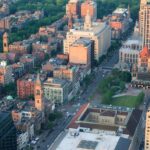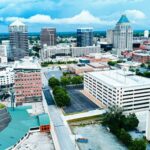
Let’s step into the dynamic world of Oregon’s cities, where population numbers are just the tip of the iceberg. Beyond the states, we’re about to dive into the heart of each city – uncovering stories, exploring cultural gems, and understanding the economic beats that make them tick.
Get ready for an exciting journey through Oregon’s cities by population, where each city has a tale to tell, and we’re here to unfold them.
Portland: The Pacific Northwest’s Metropolis
Surpassing 650,000 residents, Portland stands not merely as a city but as the pulsating heart of the Pacific Northwest.
- Cultural Epicenter: Portland’s cultural richness extends from the iconic Powell’s City of Books to the eclectic Pearl District, reflecting a vibrant and diverse cultural tapestry;
- Economic Dynamics: As Oregon’s largest economic hub, Portland’s economic landscape is multifaceted, encompassing technology, manufacturing, and a burgeoning startup scene.
Salem: Balancing Tradition and Innovation
- Population: Home to around 175,000 residents, Salem epitomizes Oregon’s blend of tradition and progress;
- Cultural Heritage: Salem’s historic landmarks, including the Capitol and Deepwood Estate, coexist harmoniously with a thriving contemporary cultural scene;
- Economic Innovation: Balancing tradition with innovation, Salem fosters economic growth, from the academic endeavors at Willamette University to the emergence of tech startups.
Eugene: A Cultural Oasis in Oregon
- Population: With approximately 172,000 residents, Eugene emerges as an enchanting blend of culture, nature, and academia;
- Cultural Nexus: Eugene’s cultural oasis is marked by events like the Oregon Bach Festival and numerous art galleries, fostering a vibrant and artistic community;
- Educational Enrichment: The presence of the University of Oregon adds an intellectual layer, establishing Eugene as a city thriving on education and the arts.
Gresham: Suburban Tranquility with Urban Allure

Surpassing 113,000 residents, Gresham is a thriving city seamlessly blending suburban tranquility with urban allure. Reflecting its diverse population, Gresham’s cultural offerings, including events, parks, and community activities, contribute to a vibrant local scene.
Beyond its role as a retail hub, Gresham’s economic resilience is evident in healthcare services, manufacturing, and a growing tech presence.
Hillsboro: Tech Hub Amidst Natural Grandeur
- Population: Hosting over 110,000 residents, Hillsboro emerges as a tech powerhouse nestled in the natural beauty of Oregon;
- Cultural Harmony: Hillsboro strikes a balance between cultural events, parks, and outdoor activities, creating a harmonious lifestyle against the backdrop of technological innovation;
- Economic Backbone: As a significant player in the tech sector, Hillsboro hosts major companies, adding to its economic vitality and influence.
Beaverton: Green Spaces in Urbanity
- Population: With around 100,000 residents, Beaverton stands as an urban oasis committed to green spaces;
- Cultural Retreat: Beaverton’s cultural scene is enriched by events, parks, and recreational activities, offering residents an urban retreat in the midst of greenery;
- Economic Influence: Focused on sports and outdoor equipment industries, Beaverton significantly contributes to the region’s economic landscape.
Bend: Nature’s Playground with Urban Flair
- Population: Boasting around 97,000 residents, Bend is a haven where nature seamlessly intertwines with urban living;
- Natural Wonders: Surrounded by mountains and rivers, Bend’s residents enjoy a plethora of outdoor activities, including hiking, skiing, and river rafting;
- Cultural Vibrancy: Adding an urban pulse, art galleries, breweries, and music festivals infuse Bend’s natural playground with cultural vibrancy.
Bend is the one of the best cities for living in this rate, discover other cities for comfort living in Oregon
Medford: Southern Oregon’s Economic Power
- Population: Medford, home to approximately 83,000 residents, stands as a vital economic hub in Southern Oregon;
- Economic Pillars: Anchored by healthcare, manufacturing, and agriculture, Medford’s economy reflects the region’s diverse economic landscape;
- Cultural Evolution: As the city grows, its cultural scene evolves, marked by community events, festivals, and outdoor activities.
Springfield: Growing Dynamics and Cultural Flourish
- Population: Home to about 70,000 residents, Springfield navigates a path of growth while nurturing its cultural identity;
- Urban Expansion: Witnessing both residential and commercial growth, Springfield is a city in transition, shaping its evolving identity;
- Cultural Blooms: Springfield’s cultural offerings are on the rise, featuring a burgeoning culinary scene, parks, and community events contributing to its urban vitality.
Corvallis: Academic Excellence in Scenic Beauty
With around 60,000 residents, Corvallis shines as a city focused on academic and research excellence.

Dominated by Oregon State University, Corvallis offers an environment conducive to intellectual pursuits, creating an academic haven.
The city’s rich cultural scene, including theaters, art galleries, and community events, adds a charming layer to its academic setting.
Albany: Where Heritage Meets Modern Dynamism
Nestled in the heart of Oregon, Albany boasts a population of approximately 55,000 residents, forming a community that beautifully blends heritage and modern dynamism.
- Cultural Fusion: Albany’s historic charm is reflected in its well-preserved architecture, including the Historic Carousel & Museum, seamlessly intertwined with a modern cultural scene that embraces local art and music;
- Economic Diversity: Beyond its historical significance, Albany thrives with economic diversity, encompassing agriculture, manufacturing, and a growing emphasis on sustainable practices, contributing to the city’s economic vibrancy.
Additional Urban Giants: Vancouver

- Population: Exceeding 190,000 residents, Vancouver, though technically in Washington, is often considered part of the greater Portland area;
- Cultural Heritage: Fort Vancouver National Historic Site preserves the city’s rich history, reflecting its role as a vital hub in the region’s past;
- Economic Vibrancy: From Pearson Field, one of the oldest continually operating airfields in the U.S., to the bustling waterfront, Vancouver showcases economic vitality beyond state lines.
Junction City: Communal Charm in the Eugene Orbit
As a satellite city of Eugene, Junction City embodies communal charm with a population of over 6,000 residents.
- Cultural Fabric: The city’s sense of community is evident in events like the Scandinavian Festival, celebrating the area’s cultural heritage;
- Economic Collaboration: Junction City’s economic ties to Eugene contribute to a collaborative regional approach to growth and development.
Creswell: A Tranquil Corner in Eugene’s Vicinity
Creswell, with a population of over 5,000 residents, is a tranquil corner in Eugene’s vicinity.
- Natural Appeal: Surrounded by farmland and characterized by a serene atmosphere, Creswell offers a retreat from the urban hustle;
- Community Engagement: The city’s small size fosters strong community engagement, with local events and initiatives that bring residents together.
Future Outlook and Collaborative Urban Planning
Vancouver’s population continues to grow, driven by its proximity to Portland and economic opportunities. Junction City and Creswell, while more modest in size, showcase stability with a focus on preserving their distinct identities.
The interconnectedness of these cities with their Oregon counterparts is evident in collaborative urban planning initiatives. Shared transportation infrastructure, environmental initiatives, and regional development projects exemplify a cooperative approach to sustainable growth.
The Distinct Urban Identity of Vancouver and Satellite Cities
Vancouver, with its position in Washington, plays a pivotal role in the broader metropolitan area, influencing and being influenced by the cultural and economic dynamics of both Washington and Oregon.
Junction City’s communal spirit, showcased through events like the Scandinavian Festival, exemplifies the city’s commitment to preserving its cultural heritage and fostering a sense of community.
Creswell, as a tranquil corner in Eugene’s vicinity, represents a resilient community that values its natural surroundings and emphasizes local engagement.
Future Projections and Urban Planning in Oregon
Analyzing population trends in these cities provides insights into the future. For instance, Portland’s steady growth is forecasted to continue, while smaller cities like Corvallis may see more modest increases, shaped by factors such as university enrollment and employment opportunities.
Cities across Oregon are implementing innovative urban planning initiatives to ensure sustainable growth. From transportation infrastructure projects to green spaces and eco-friendly urban development, these initiatives aim to create livable, resilient cities for future generations.
Oregon’s Unique Urban Identity
Oregon’s urban identity is a patchwork quilt of diverse cities, each contributing its unique stitch to the fabric of the state. From the cultural vibrancy of Eugene to the economic engines of Hillsboro, Oregon’s cities are a testament to the state’s ability to balance progress with environmental consciousness.
Conclusion
And there you have it – a rollercoaster ride through Oregon’s vibrant urban hubs. From the iconic Portland to the academic charm of Corvallis, these cities are more than just numbers; they’re living, breathing entities with unique identities.
This exploration of Oregon’s cities by population is an ongoing narrative, a blend of growth, culture, and a spirit that defines the Pacific Northwest. The cities keep evolving, and so does the captivating tale of Oregon.
Last modified: February 29, 2024

